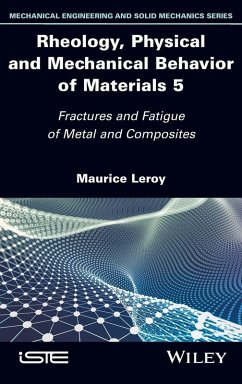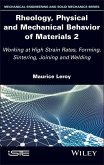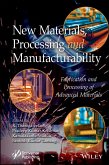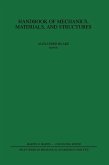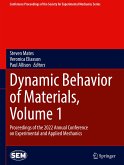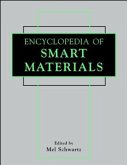Maurice Leroy
Rheology, Physical and Mechanical Behavior of Materials, Volume 5
Fractures and Fatigue of Metal and Composites
Maurice Leroy
Rheology, Physical and Mechanical Behavior of Materials, Volume 5
Fractures and Fatigue of Metal and Composites
- Gebundenes Buch
Andere Kunden interessierten sich auch für
![Rheology, Physical and Mechanical Behavior of Materials 4 Rheology, Physical and Mechanical Behavior of Materials 4]() Maurice LeroyRheology, Physical and Mechanical Behavior of Materials 4144,99 €
Maurice LeroyRheology, Physical and Mechanical Behavior of Materials 4144,99 €![Rheology, Physical and Mechanical Behavior of Materials 2 Rheology, Physical and Mechanical Behavior of Materials 2]() Maurice LeroyRheology, Physical and Mechanical Behavior of Materials 2144,99 €
Maurice LeroyRheology, Physical and Mechanical Behavior of Materials 2144,99 €![New Materials, Processing and Manufacturability New Materials, Processing and Manufacturability]() ThanigaivelanNew Materials, Processing and Manufacturability197,99 €
ThanigaivelanNew Materials, Processing and Manufacturability197,99 €![Handbook of Mechanics, Materials, and Structures Handbook of Mechanics, Materials, and Structures]() A BlakeHandbook of Mechanics, Materials, and Structures320,99 €
A BlakeHandbook of Mechanics, Materials, and Structures320,99 €![Memoirs Of Deceased American Investigators Who Have Contributed In A Marked Degree To The Advance Of The Testing Of Materials, Volume 7, Issue 16 Memoirs Of Deceased American Investigators Who Have Contributed In A Marked Degree To The Advance Of The Testing Of Materials, Volume 7, Issue 16]() Gaetano LanzaMemoirs Of Deceased American Investigators Who Have Contributed In A Marked Degree To The Advance Of The Testing Of Materials, Volume 7, Issue 1628,99 €
Gaetano LanzaMemoirs Of Deceased American Investigators Who Have Contributed In A Marked Degree To The Advance Of The Testing Of Materials, Volume 7, Issue 1628,99 €![Dynamic Behavior of Materials, Volume 1 Dynamic Behavior of Materials, Volume 1]() Dynamic Behavior of Materials, Volume 1174,99 €
Dynamic Behavior of Materials, Volume 1174,99 €![Encyclopedia of Smart Materials, 2 Volume Set Encyclopedia of Smart Materials, 2 Volume Set]() Mel SchwartzEncyclopedia of Smart Materials, 2 Volume Set1.001,99 €
Mel SchwartzEncyclopedia of Smart Materials, 2 Volume Set1.001,99 €-
-
-
Produktdetails
- Verlag: Wiley
- Seitenzahl: 368
- Erscheinungstermin: 12. August 2025
- Englisch
- Abmessung: 237mm x 156mm x 24mm
- Gewicht: 634g
- ISBN-13: 9781836690269
- ISBN-10: 1836690266
- Artikelnr.: 74801779
- Herstellerkennzeichnung
- Libri GmbH
- Europaallee 1
- 36244 Bad Hersfeld
- gpsr@libri.de
Chapter 1 Damage 1 1.1 Definition 1 1.2 Damage variables 2 1.3 Effective stress 3 1.4 Principle of strain equivalence 5 1.5 Experimental characterization of the damage 6 1.5.1 Changes in mechanical characteristics 6 1.5.2 Modifications of the material 7 1.5.3 Wear rate 7 1.6 Models of the progression of the damage D 9 1.6.1 Dissipation 9 1.6.2 Types of damage 10 Chapter 2 Ductile Fracture 17 2.1 Stages of ductile tearing 17 2.1.1 First step: damage by decohesion, cracking of inclusions, impurities, precipitates, cavity formation 17 2.1.2 Second stage: growing cavities, formation of peduncles followed by necking, giving rise to ductile tearing 18 2.2 Linear ductile plastic damage during strain 20 2.3 Formation of cracks around inclusions or precipitates, cavities in ductile fracture 23 2.3.1 Formation of cracks from particles for Figure 2.5(b): the case of multiple metals 28 2.3.2 Aluminum-silicon alloy 29 2.4 Analysis of facies of ductile fractures of trichite and metals according to the purity and the state of the stresses 30 2.4.1 Whisker fracture (Cu and Fe) 30 2.4.2 Polycrystals CC and CFC in ductile fracture: influence of stress states and purity 33 2.4.3 Ductile fracture of steel test pieces without notches 34 2.4.4 Fracture of pure iron specimens 35 2.4.5 Ductile fracture of industrial copper specimens of purity 4N and 5N 36 2.4.6 Cases of zones of melted Fe, Cu (4N, 5N and industrial), aluminum (3N, 5N and industrial) - uniaxial and triaxial stresses 40 2.5 Relationship between the density of inclusions and ductility 44 2.5.1 Sintered copper made up of particles 44 2.5.2 Alumina 46 Chapter 3 Sudden Fracture, Fracture Energy 53 3.1 Analysis of the fracture 53 3.2 Sudden fracture and energy criterion 54 3.2.1 Energy balance causing the crack to advance 54 3.2.2 Obtaining Gc 56 3.2.3 Data for Gc and Kc 58 3.2.4 Examples of sudden fractures 64 Chapter 4 Description and Modeling of Physical Mechanisms 73 4.1 Expansion of cracks 73 4.2 Calculation of rp : the case of confined plasticity 74 4.3 Elastoplastic zone at the end of a crack 76 4.4 Stress and strain field at the end of the crack 77 Chapter 5 Fractures due to Cleavages and Intergranularity 81 5.1 Fractures from cleavages 81 5.1.1 Examples of fractures by cleavage 82 5.1.2 Change of micromechanisms 84 5.2 Intergranular fracture 85 5.2.1 Fractures along interfaces, grain boundary 85 5.2.2 Intergranular brittle fracture 86 5.2.3 Metal fracture transition parameter 87 5.2.4 Influence of the grain boundary 91 5.2.5 Cleavage strain of steels 92 5.2.6 Influence of the addition elements on the brittle-ductile transition 93 Chapter 6 Concentration of Stresses K t 97 6.1 Introduction 97 6.2 Measure of Kt 99 6.2.1 By extensometry gauges 99 6.2.2 By photoelasticimetry 100 6.3 Solids with equal resistances 101 6.4 Notching effect 102 6.5 Reduction of the stress concentration factor: the case of notched objects 104 6.6 Effect of notches under fatigue 105 6.7 Stress concentration values Kt : useful cases in practice 107 Chapter 7 The Intensity Factor of Stresses K 111 7.1 Introduction 111 7.2 Fields of stresses and movements 113 7.2.1 Mode I 113 7.2.2 Mode II 115 7.2.3 Mode III 117 7.2.4 Values of K for flat cracked medium 118 7.2.5 Area at the bottom of the crack 121 7.2.6 Influence of the plastic zone undergoing cracking 124 7.3 Remarks regarding K =
a 125 7.4 Values of the stress intensities KI , KII , KIII for the three modes: for cases related to the subject and useful cases in practice 126 7.4.1 Typical values of stress intensity factors KI , KII , KIII 126 7.4.2 Values of K I = f(
).
a 131 Chapter 8 Fracture Zones in Photoelasticimetry 137 8.1 Photoelasticity 137 8.1.1 Primary stresses and isostatic lines 137 8.1.2 Birefringence by strain 138 8.2 Propagation of light vibrations 139 8.2.1 Propagation of light in a vacuum 139 8.2.2 Propagation of light in a transparent medium 140 8.2.3 Wave in a dielectric 141 8.2.4 Values of the constants C and K of photoelastic materials 142 8.2.5 Choice of a photoelastic coating 144 8.2.6 Ellipsoid of the indices 146 8.3 Photoelasticimetry 149 8.3.1 Photoelasticimeter 149 8.3.2 Isochromatic lines, difference between the primary stresses 151 8.3.3 Example of physical parts under stresses: a three-dimensional case using the freezing method 159 Chapter 9 The Influence of Strain Speeds 161 9.1 Types of dynamic loads 161 9.2 Examples of fast fractures 163 9.3 Damage, domain between necking and fracture, the case between FLCS and LCFF 168 9.3.1 Definition 168 9.3.2 Large strains and damage 169 9.4 Forming limit curves: static stamping (under a press) and dynamic stamping (magnetoforming and electrohydroforming) 171 9.4.1 Measurement of strains 171 9.4.2 Description of an electrohydraulic (EH) test 172 9.4.3 Types of test pieces 176 9.4.4 Example of LCFFs 177 9.5 Shock by intense pulsed magnetic field on aluminum alloys 180 9.6 Test results 183 9.6.1 Strain trajectories, change of
1 according to
2 ; comparison of low and high speeds 184 9.6.2 Influence of strain speeds on FLCs, formability in static and dynamic states 187 9.6.3 Comparison of the values for necking Z and fracture F 189 Chapter 10 Metal Fatigue 197 10.1 Introduction 197 10.2 Endurance curve: plot of the endurance curve or Wöhler curve 197 10.3 Conventional endurance limit 199 10.4 Classification of fatigue tests 201 10.4.1 Definition 201 10.4.2 Tests in practice 203 10.4.3 Combined stress tests 205 10.4.4 Application of a criterion in planar stress 212 10.4.5 Examples of influences on endurance 216 10.4.6 Influence of temperature 217 10.5 Physical aspects of fatigue 219 10.5.1 Physical mechanisms 219 10.5.2 Fatigue fracture surfaces, microscope images 222 10.5.3 Change of the streak spacing 223 10.5.4 Examples of micrograph images of fractures 224 10.6 Types of fatigue 225 10.6.1 Behavior of non-cracked parts under fatigue 226 10.6.2 Behavior of non-cracked parts under fatigue 230 10.7 Plasticity, fast fracture by fatigue: a case study 235 10.8 Propagation of corrosion cracks under fatigue-corrosion stress and influence of cycle frequencies 241 Chapter 11 Fracture of Composites 247 11.1 Fracture mechanisms 247 11.1.1 Unidirectional composite (UD) 247 11.1.2 Fracture of laminates 252 11.2 Criteria for fracture 254 11.2.1 Data describing the resistance of a UD or a fabric 254 11.2.2 Successive fractures of layers 256 11.2.3 Strength/stress ratio: coefficient of resistance R 256 11.2.4 Criteria for maximum stress and/or maximum strain 257 11.2.5 Quadratic criterion: in the stress space 259 11.2.6 Fracture envelopes 264 11.3 Design in primary strains 266 11.3.1 Principal stresses and strains 266 11.3.2 Constants of stresses and strains 267 11.3.3 Scaling of isotropes 268 Appendices 275 References 331 Index 335
a 125 7.4 Values of the stress intensities KI , KII , KIII for the three modes: for cases related to the subject and useful cases in practice 126 7.4.1 Typical values of stress intensity factors KI , KII , KIII 126 7.4.2 Values of K I = f(
).
a 131 Chapter 8 Fracture Zones in Photoelasticimetry 137 8.1 Photoelasticity 137 8.1.1 Primary stresses and isostatic lines 137 8.1.2 Birefringence by strain 138 8.2 Propagation of light vibrations 139 8.2.1 Propagation of light in a vacuum 139 8.2.2 Propagation of light in a transparent medium 140 8.2.3 Wave in a dielectric 141 8.2.4 Values of the constants C and K of photoelastic materials 142 8.2.5 Choice of a photoelastic coating 144 8.2.6 Ellipsoid of the indices 146 8.3 Photoelasticimetry 149 8.3.1 Photoelasticimeter 149 8.3.2 Isochromatic lines, difference between the primary stresses 151 8.3.3 Example of physical parts under stresses: a three-dimensional case using the freezing method 159 Chapter 9 The Influence of Strain Speeds 161 9.1 Types of dynamic loads 161 9.2 Examples of fast fractures 163 9.3 Damage, domain between necking and fracture, the case between FLCS and LCFF 168 9.3.1 Definition 168 9.3.2 Large strains and damage 169 9.4 Forming limit curves: static stamping (under a press) and dynamic stamping (magnetoforming and electrohydroforming) 171 9.4.1 Measurement of strains 171 9.4.2 Description of an electrohydraulic (EH) test 172 9.4.3 Types of test pieces 176 9.4.4 Example of LCFFs 177 9.5 Shock by intense pulsed magnetic field on aluminum alloys 180 9.6 Test results 183 9.6.1 Strain trajectories, change of
1 according to
2 ; comparison of low and high speeds 184 9.6.2 Influence of strain speeds on FLCs, formability in static and dynamic states 187 9.6.3 Comparison of the values for necking Z and fracture F 189 Chapter 10 Metal Fatigue 197 10.1 Introduction 197 10.2 Endurance curve: plot of the endurance curve or Wöhler curve 197 10.3 Conventional endurance limit 199 10.4 Classification of fatigue tests 201 10.4.1 Definition 201 10.4.2 Tests in practice 203 10.4.3 Combined stress tests 205 10.4.4 Application of a criterion in planar stress 212 10.4.5 Examples of influences on endurance 216 10.4.6 Influence of temperature 217 10.5 Physical aspects of fatigue 219 10.5.1 Physical mechanisms 219 10.5.2 Fatigue fracture surfaces, microscope images 222 10.5.3 Change of the streak spacing 223 10.5.4 Examples of micrograph images of fractures 224 10.6 Types of fatigue 225 10.6.1 Behavior of non-cracked parts under fatigue 226 10.6.2 Behavior of non-cracked parts under fatigue 230 10.7 Plasticity, fast fracture by fatigue: a case study 235 10.8 Propagation of corrosion cracks under fatigue-corrosion stress and influence of cycle frequencies 241 Chapter 11 Fracture of Composites 247 11.1 Fracture mechanisms 247 11.1.1 Unidirectional composite (UD) 247 11.1.2 Fracture of laminates 252 11.2 Criteria for fracture 254 11.2.1 Data describing the resistance of a UD or a fabric 254 11.2.2 Successive fractures of layers 256 11.2.3 Strength/stress ratio: coefficient of resistance R 256 11.2.4 Criteria for maximum stress and/or maximum strain 257 11.2.5 Quadratic criterion: in the stress space 259 11.2.6 Fracture envelopes 264 11.3 Design in primary strains 266 11.3.1 Principal stresses and strains 266 11.3.2 Constants of stresses and strains 267 11.3.3 Scaling of isotropes 268 Appendices 275 References 331 Index 335
Chapter 1 Damage 1 1.1 Definition 1 1.2 Damage variables 2 1.3 Effective stress 3 1.4 Principle of strain equivalence 5 1.5 Experimental characterization of the damage 6 1.5.1 Changes in mechanical characteristics 6 1.5.2 Modifications of the material 7 1.5.3 Wear rate 7 1.6 Models of the progression of the damage D 9 1.6.1 Dissipation 9 1.6.2 Types of damage 10 Chapter 2 Ductile Fracture 17 2.1 Stages of ductile tearing 17 2.1.1 First step: damage by decohesion, cracking of inclusions, impurities, precipitates, cavity formation 17 2.1.2 Second stage: growing cavities, formation of peduncles followed by necking, giving rise to ductile tearing 18 2.2 Linear ductile plastic damage during strain 20 2.3 Formation of cracks around inclusions or precipitates, cavities in ductile fracture 23 2.3.1 Formation of cracks from particles for Figure 2.5(b): the case of multiple metals 28 2.3.2 Aluminum-silicon alloy 29 2.4 Analysis of facies of ductile fractures of trichite and metals according to the purity and the state of the stresses 30 2.4.1 Whisker fracture (Cu and Fe) 30 2.4.2 Polycrystals CC and CFC in ductile fracture: influence of stress states and purity 33 2.4.3 Ductile fracture of steel test pieces without notches 34 2.4.4 Fracture of pure iron specimens 35 2.4.5 Ductile fracture of industrial copper specimens of purity 4N and 5N 36 2.4.6 Cases of zones of melted Fe, Cu (4N, 5N and industrial), aluminum (3N, 5N and industrial) - uniaxial and triaxial stresses 40 2.5 Relationship between the density of inclusions and ductility 44 2.5.1 Sintered copper made up of particles 44 2.5.2 Alumina 46 Chapter 3 Sudden Fracture, Fracture Energy 53 3.1 Analysis of the fracture 53 3.2 Sudden fracture and energy criterion 54 3.2.1 Energy balance causing the crack to advance 54 3.2.2 Obtaining Gc 56 3.2.3 Data for Gc and Kc 58 3.2.4 Examples of sudden fractures 64 Chapter 4 Description and Modeling of Physical Mechanisms 73 4.1 Expansion of cracks 73 4.2 Calculation of rp : the case of confined plasticity 74 4.3 Elastoplastic zone at the end of a crack 76 4.4 Stress and strain field at the end of the crack 77 Chapter 5 Fractures due to Cleavages and Intergranularity 81 5.1 Fractures from cleavages 81 5.1.1 Examples of fractures by cleavage 82 5.1.2 Change of micromechanisms 84 5.2 Intergranular fracture 85 5.2.1 Fractures along interfaces, grain boundary 85 5.2.2 Intergranular brittle fracture 86 5.2.3 Metal fracture transition parameter 87 5.2.4 Influence of the grain boundary 91 5.2.5 Cleavage strain of steels 92 5.2.6 Influence of the addition elements on the brittle-ductile transition 93 Chapter 6 Concentration of Stresses K t 97 6.1 Introduction 97 6.2 Measure of Kt 99 6.2.1 By extensometry gauges 99 6.2.2 By photoelasticimetry 100 6.3 Solids with equal resistances 101 6.4 Notching effect 102 6.5 Reduction of the stress concentration factor: the case of notched objects 104 6.6 Effect of notches under fatigue 105 6.7 Stress concentration values Kt : useful cases in practice 107 Chapter 7 The Intensity Factor of Stresses K 111 7.1 Introduction 111 7.2 Fields of stresses and movements 113 7.2.1 Mode I 113 7.2.2 Mode II 115 7.2.3 Mode III 117 7.2.4 Values of K for flat cracked medium 118 7.2.5 Area at the bottom of the crack 121 7.2.6 Influence of the plastic zone undergoing cracking 124 7.3 Remarks regarding K =
a 125 7.4 Values of the stress intensities KI , KII , KIII for the three modes: for cases related to the subject and useful cases in practice 126 7.4.1 Typical values of stress intensity factors KI , KII , KIII 126 7.4.2 Values of K I = f(
).
a 131 Chapter 8 Fracture Zones in Photoelasticimetry 137 8.1 Photoelasticity 137 8.1.1 Primary stresses and isostatic lines 137 8.1.2 Birefringence by strain 138 8.2 Propagation of light vibrations 139 8.2.1 Propagation of light in a vacuum 139 8.2.2 Propagation of light in a transparent medium 140 8.2.3 Wave in a dielectric 141 8.2.4 Values of the constants C and K of photoelastic materials 142 8.2.5 Choice of a photoelastic coating 144 8.2.6 Ellipsoid of the indices 146 8.3 Photoelasticimetry 149 8.3.1 Photoelasticimeter 149 8.3.2 Isochromatic lines, difference between the primary stresses 151 8.3.3 Example of physical parts under stresses: a three-dimensional case using the freezing method 159 Chapter 9 The Influence of Strain Speeds 161 9.1 Types of dynamic loads 161 9.2 Examples of fast fractures 163 9.3 Damage, domain between necking and fracture, the case between FLCS and LCFF 168 9.3.1 Definition 168 9.3.2 Large strains and damage 169 9.4 Forming limit curves: static stamping (under a press) and dynamic stamping (magnetoforming and electrohydroforming) 171 9.4.1 Measurement of strains 171 9.4.2 Description of an electrohydraulic (EH) test 172 9.4.3 Types of test pieces 176 9.4.4 Example of LCFFs 177 9.5 Shock by intense pulsed magnetic field on aluminum alloys 180 9.6 Test results 183 9.6.1 Strain trajectories, change of
1 according to
2 ; comparison of low and high speeds 184 9.6.2 Influence of strain speeds on FLCs, formability in static and dynamic states 187 9.6.3 Comparison of the values for necking Z and fracture F 189 Chapter 10 Metal Fatigue 197 10.1 Introduction 197 10.2 Endurance curve: plot of the endurance curve or Wöhler curve 197 10.3 Conventional endurance limit 199 10.4 Classification of fatigue tests 201 10.4.1 Definition 201 10.4.2 Tests in practice 203 10.4.3 Combined stress tests 205 10.4.4 Application of a criterion in planar stress 212 10.4.5 Examples of influences on endurance 216 10.4.6 Influence of temperature 217 10.5 Physical aspects of fatigue 219 10.5.1 Physical mechanisms 219 10.5.2 Fatigue fracture surfaces, microscope images 222 10.5.3 Change of the streak spacing 223 10.5.4 Examples of micrograph images of fractures 224 10.6 Types of fatigue 225 10.6.1 Behavior of non-cracked parts under fatigue 226 10.6.2 Behavior of non-cracked parts under fatigue 230 10.7 Plasticity, fast fracture by fatigue: a case study 235 10.8 Propagation of corrosion cracks under fatigue-corrosion stress and influence of cycle frequencies 241 Chapter 11 Fracture of Composites 247 11.1 Fracture mechanisms 247 11.1.1 Unidirectional composite (UD) 247 11.1.2 Fracture of laminates 252 11.2 Criteria for fracture 254 11.2.1 Data describing the resistance of a UD or a fabric 254 11.2.2 Successive fractures of layers 256 11.2.3 Strength/stress ratio: coefficient of resistance R 256 11.2.4 Criteria for maximum stress and/or maximum strain 257 11.2.5 Quadratic criterion: in the stress space 259 11.2.6 Fracture envelopes 264 11.3 Design in primary strains 266 11.3.1 Principal stresses and strains 266 11.3.2 Constants of stresses and strains 267 11.3.3 Scaling of isotropes 268 Appendices 275 References 331 Index 335
a 125 7.4 Values of the stress intensities KI , KII , KIII for the three modes: for cases related to the subject and useful cases in practice 126 7.4.1 Typical values of stress intensity factors KI , KII , KIII 126 7.4.2 Values of K I = f(
).
a 131 Chapter 8 Fracture Zones in Photoelasticimetry 137 8.1 Photoelasticity 137 8.1.1 Primary stresses and isostatic lines 137 8.1.2 Birefringence by strain 138 8.2 Propagation of light vibrations 139 8.2.1 Propagation of light in a vacuum 139 8.2.2 Propagation of light in a transparent medium 140 8.2.3 Wave in a dielectric 141 8.2.4 Values of the constants C and K of photoelastic materials 142 8.2.5 Choice of a photoelastic coating 144 8.2.6 Ellipsoid of the indices 146 8.3 Photoelasticimetry 149 8.3.1 Photoelasticimeter 149 8.3.2 Isochromatic lines, difference between the primary stresses 151 8.3.3 Example of physical parts under stresses: a three-dimensional case using the freezing method 159 Chapter 9 The Influence of Strain Speeds 161 9.1 Types of dynamic loads 161 9.2 Examples of fast fractures 163 9.3 Damage, domain between necking and fracture, the case between FLCS and LCFF 168 9.3.1 Definition 168 9.3.2 Large strains and damage 169 9.4 Forming limit curves: static stamping (under a press) and dynamic stamping (magnetoforming and electrohydroforming) 171 9.4.1 Measurement of strains 171 9.4.2 Description of an electrohydraulic (EH) test 172 9.4.3 Types of test pieces 176 9.4.4 Example of LCFFs 177 9.5 Shock by intense pulsed magnetic field on aluminum alloys 180 9.6 Test results 183 9.6.1 Strain trajectories, change of
1 according to
2 ; comparison of low and high speeds 184 9.6.2 Influence of strain speeds on FLCs, formability in static and dynamic states 187 9.6.3 Comparison of the values for necking Z and fracture F 189 Chapter 10 Metal Fatigue 197 10.1 Introduction 197 10.2 Endurance curve: plot of the endurance curve or Wöhler curve 197 10.3 Conventional endurance limit 199 10.4 Classification of fatigue tests 201 10.4.1 Definition 201 10.4.2 Tests in practice 203 10.4.3 Combined stress tests 205 10.4.4 Application of a criterion in planar stress 212 10.4.5 Examples of influences on endurance 216 10.4.6 Influence of temperature 217 10.5 Physical aspects of fatigue 219 10.5.1 Physical mechanisms 219 10.5.2 Fatigue fracture surfaces, microscope images 222 10.5.3 Change of the streak spacing 223 10.5.4 Examples of micrograph images of fractures 224 10.6 Types of fatigue 225 10.6.1 Behavior of non-cracked parts under fatigue 226 10.6.2 Behavior of non-cracked parts under fatigue 230 10.7 Plasticity, fast fracture by fatigue: a case study 235 10.8 Propagation of corrosion cracks under fatigue-corrosion stress and influence of cycle frequencies 241 Chapter 11 Fracture of Composites 247 11.1 Fracture mechanisms 247 11.1.1 Unidirectional composite (UD) 247 11.1.2 Fracture of laminates 252 11.2 Criteria for fracture 254 11.2.1 Data describing the resistance of a UD or a fabric 254 11.2.2 Successive fractures of layers 256 11.2.3 Strength/stress ratio: coefficient of resistance R 256 11.2.4 Criteria for maximum stress and/or maximum strain 257 11.2.5 Quadratic criterion: in the stress space 259 11.2.6 Fracture envelopes 264 11.3 Design in primary strains 266 11.3.1 Principal stresses and strains 266 11.3.2 Constants of stresses and strains 267 11.3.3 Scaling of isotropes 268 Appendices 275 References 331 Index 335

